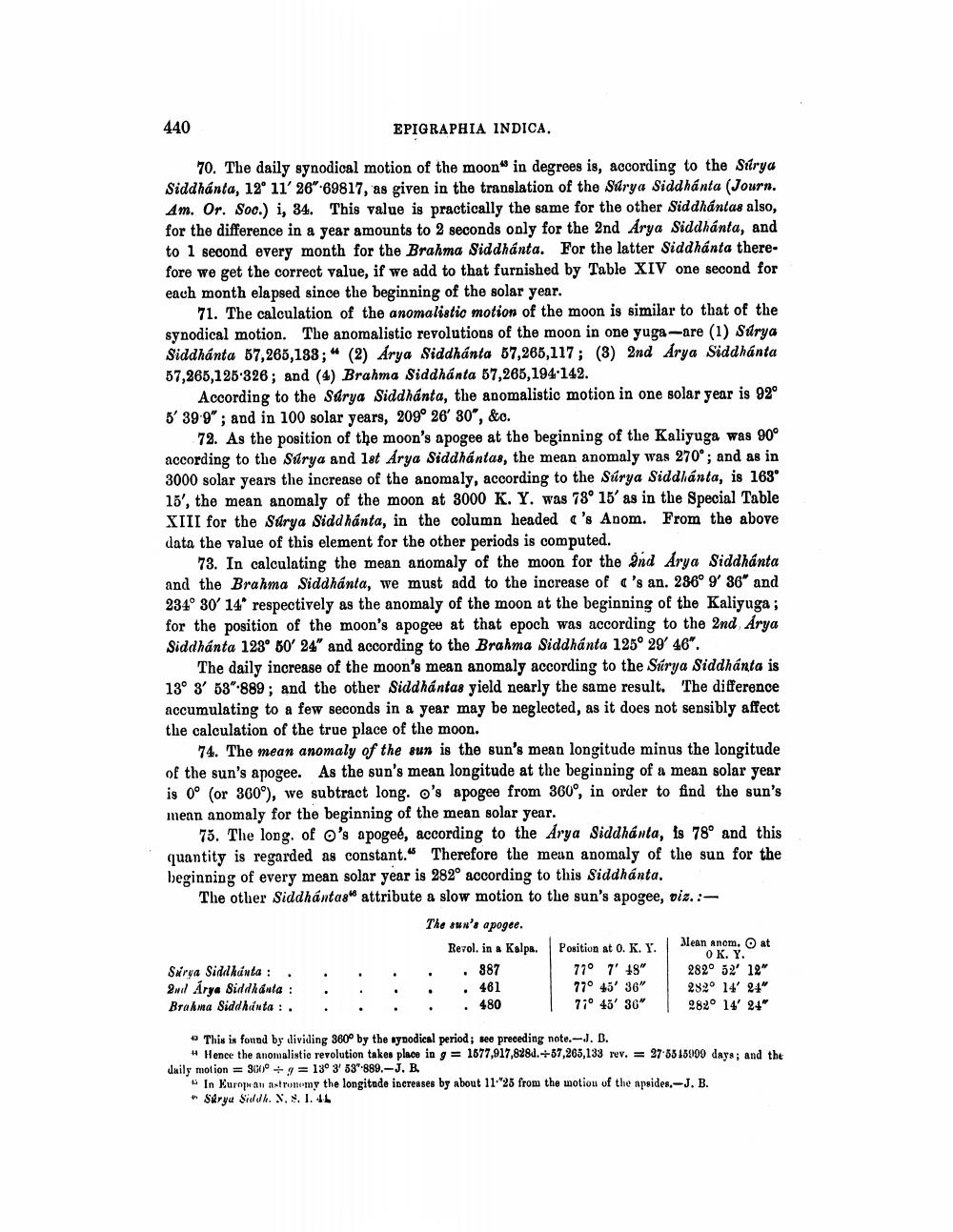________________
440
EPIGRAPHIA INDICA.
70. The daily synodical motion of the moon in degrees is, according to the Sitrya Siddhanta, 12° 11' 26"-69817, as given in the translation of the Súrya Siddhanta (Journ. Am. Or. Soc.) i, 34. This value is practically the same for the other Siddhantas also, for the difference in a year amounts to 2 seconds only for the 2nd Arya Siddhánta, and to 1 second every month for the Brahma Siddhanta. For the latter Siddhanta there. fore we get the correct value, if we add to that furnished by Table XIV one second for each month elapsed since the beginning of the solar year.
71. The calculation of the anomalistic motion of the moon is similar to that of the synodical motion. The anomalistic revolutions of the moon in one yuga-are (1) Súrya Siddhanta 57,265,133;" (2) Arya Siddhanta 57,265,117; (3) 2nd Arya Siddhanta 57,265,125.326; and (4) Brahma Siddhanta 57,265,194.142.
According to the Sarya Siddhanta, the anomalistic motion in one solar year is 92° 5' 399"; and in 100 solar years, 209° 26' 30', &c.
72. As the position of the moon's apogee at the beginning of the Kaliyuga was 90° according to the Surya and 1st Arya Siddhantas, the mean anomaly was 270°; and as in 3000 solar years the increase of the anomaly, according to the Súrya Siddlánta, is 163 15', the mean anomaly of the moon at 3000 K. Y. was 78° 15' as in the Special Table XIII for the Súrya Sidd hánta, in the column headed ('s Anom. From the above data the value of this element for the other periods is computed.
73. In calculating the mean anomaly of the moon for the 2nd Arya Siddhanta and the Brahma Siddhanta, we must add to the increase of c's an. 286° 9' 36" and 234° 30' 14' respectively as the anomaly of the moon at the beginning of the Kaliyuga; for the position of the moon's apogee at that epoch was according to the 2nd Arya Siddhanta 123° 50' 24" and according to the Brahma Siddhanta 125° 29' 46".
The daily increase of the moon's mean anomaly according to the Súrya Siddhanta is 13° 3' 53"889; and the other Siddhantas yield nearly the same result. The difference accumulating to a few seconds in a year may be neglected, as it does not sensibly affect the calculation of the true place of the moon.
74. The mean anomaly of the sun is the sun's mean longitude minus the longitude of the sun's apogee. As the sun's mean longitude at the beginning of a mean solar year is 0o (or 360°), we subtract long. o's apogee from 360°, in order to find the sun's mean anomaly for the beginning of the mean solar year.
75. The long. of O's apogeé, according to the Arya Siddhánta, is 78° and this quantity is regarded as constant. Therefore the mean anomaly of the sun for the beginning of every mean solar year is 282° according to this Siddhanta. The other Siddhantas attribute a slow motion to the sun's apogee, viz. :
The sun's apogee. Rezol. in a Kalpa. Position at 0.K. Y. Alean anom, o at
OK. Y. Surya Sidekunta: . . . . . . 887
77° 7' 18" 282° 52' 12" 2.dl Arya Siddhanta : :
461
77° 45' 36" 282° 14' 24" Brakma Siddhinta :. .
71° 45' 36" 282° 14' 24"
.
480
• This is found by dividing 360° by the synodical period; see preceding note.-J. B.
# Hence the Anomalistic revolution takes place in g = 1577,917,8281.+37,265,133 rev. = 375818000 days; and the daily motion = 300° = 13° 3' 53"-889.-J. B.
In Europa stronomy the longitude increases by about 11.25 from the motiou of the apsides.-J. B. "Saryu Sidih. X. $. I. 11




